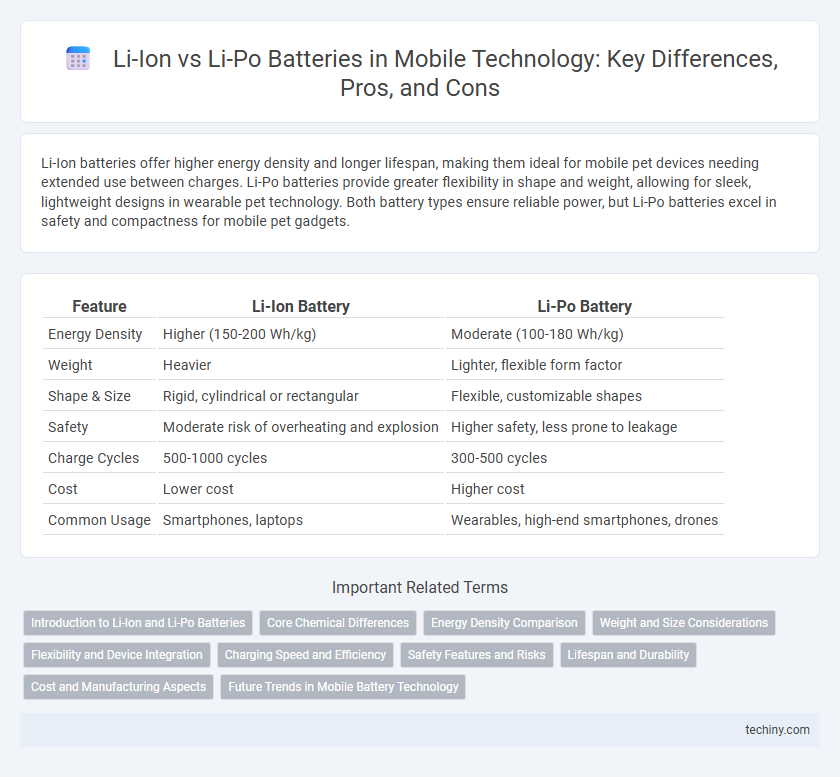Li-Ion batteries offer higher energy density and longer lifespan, making them ideal for mobile pet devices needing extended use between charges. Li-Po batteries provide greater flexibility in shape and weight, allowing for sleek, lightweight designs in wearable pet technology. Both battery types ensure reliable power, but Li-Po batteries excel in safety and compactness for mobile pet gadgets.
Table of Comparison
| Feature | Li-Ion Battery | Li-Po Battery |
|---|---|---|
| Energy Density | Higher (150-200 Wh/kg) | Moderate (100-180 Wh/kg) |
| Weight | Heavier | Lighter, flexible form factor |
| Shape & Size | Rigid, cylindrical or rectangular | Flexible, customizable shapes |
| Safety | Moderate risk of overheating and explosion | Higher safety, less prone to leakage |
| Charge Cycles | 500-1000 cycles | 300-500 cycles |
| Cost | Lower cost | Higher cost |
| Common Usage | Smartphones, laptops | Wearables, high-end smartphones, drones |
Introduction to Li-Ion and Li-Po Batteries
Li-Ion batteries, known for their high energy density and long cycle life, are widely used in mobile devices due to their efficiency and durability. Li-Po batteries feature a flexible, lightweight design with a solid polymer electrolyte, allowing for varied shapes and enhanced safety. Both battery types power smartphones and tablets, balancing energy performance and design adaptability.
Core Chemical Differences
Li-Ion batteries utilize a liquid electrolyte that allows lithium ions to move between the anode and cathode during charge and discharge cycles, offering high energy density but posing leakage risks. Li-Po batteries employ a solid or gel-like polymer electrolyte, enhancing flexibility and safety by reducing the chance of electrolyte leakage and enabling thinner, more adaptable designs. The core chemical variation lies in the state of the electrolyte, influencing battery performance, weight, shape, and thermal stability in mobile technology applications.
Energy Density Comparison
Li-Ion batteries possess a higher energy density, typically ranging from 150 to 200 Wh/kg, which translates to longer battery life for mobile devices. Li-Po batteries offer energy densities around 100 to 150 Wh/kg but provide enhanced design flexibility due to their lightweight and flexible form factor. The superior energy density of Li-Ion batteries makes them ideal for smartphones and laptops requiring extended usage between charges.
Weight and Size Considerations
Li-Ion batteries typically offer higher energy density but are heavier and bulkier compared to Li-Po batteries, which benefit from a more flexible form factor and lightweight design ideal for slim mobile devices. Li-Po batteries can be manufactured in various shapes and sizes, contributing to thinner and lighter smartphones, tablets, and wearable gadgets. Manufacturers often prefer Li-Po technology for compact mobile devices where minimizing weight and size is critical for enhancing portability and user comfort.
Flexibility and Device Integration
Li-Po batteries offer superior flexibility and can be molded into various shapes and sizes, making them ideal for compact and irregularly shaped mobile devices. Li-Ion batteries, typically rigid and cylindrical, limit design options and device form factors. The enhanced adaptability of Li-Po batteries enables seamless integration into modern smartphones, tablets, and wearable technology.
Charging Speed and Efficiency
Li-Ion batteries typically offer faster charging speeds due to higher energy density and stable charge acceptance, making them efficient for rapid power replenishment in mobile devices. Li-Po batteries, while slightly slower to charge, excel in energy efficiency by maintaining consistent voltage levels and reducing energy loss during charge cycles. Both technologies optimize mobile device performance, but Li-Ion's rapid charging capability often provides a more advantageous user experience for quick device turnaround.
Safety Features and Risks
Li-Ion batteries typically offer higher energy density but carry a greater risk of thermal runaway, making safety features like pressure relief valves and protective circuits essential to prevent overheating and fires. Li-Po batteries provide enhanced safety with a solid or gel-like electrolyte that reduces leakage risk and improves resistance to swelling and puncture, making them preferable in rugged mobile devices. Both battery types require careful management systems to mitigate risks like overcharging, short-circuiting, and physical damage for optimal safety in mobile technology applications.
Lifespan and Durability
Li-Ion batteries typically offer a longer lifespan with around 500 to 1,000 charge cycles before capacity degrades significantly, making them suitable for prolonged use in mobile devices. Li-Po (Lithium Polymer) batteries provide enhanced durability due to their flexible, lightweight design and better resistance to physical stress, reducing the risk of swelling and damage. Both battery types maintain efficient performance, but Li-Po batteries excel in durability while Li-Ion batteries focus on maximizing lifespan.
Cost and Manufacturing Aspects
Li-Ion batteries are generally less expensive to manufacture due to their simpler construction and established large-scale production processes, making them cost-effective for mass-market mobile devices. Li-Po batteries, while more expensive, offer greater design flexibility and improved safety, which requires more complex and costly manufacturing techniques such as the use of polymer electrolytes and advanced sealing methods. The cost difference in raw materials and production intricacies significantly influences the choice between Li-Ion and Li-Po batteries in mobile technology applications.
Future Trends in Mobile Battery Technology
Li-Ion batteries have dominated mobile technology due to high energy density and long cycle life, but Li-Po batteries are gaining traction because of their flexible form factors and improved safety profiles. Future trends indicate a shift towards solid-state batteries that combine the best of both technologies, offering faster charging, higher capacity, and enhanced thermal stability for next-generation mobile devices. Advances in nano-materials and electrolyte innovations will further optimize battery efficiency, extending device lifespan and supporting increasingly powerful mobile applications.
Li-Ion Battery vs Li-Po Battery Infographic

 techiny.com
techiny.com